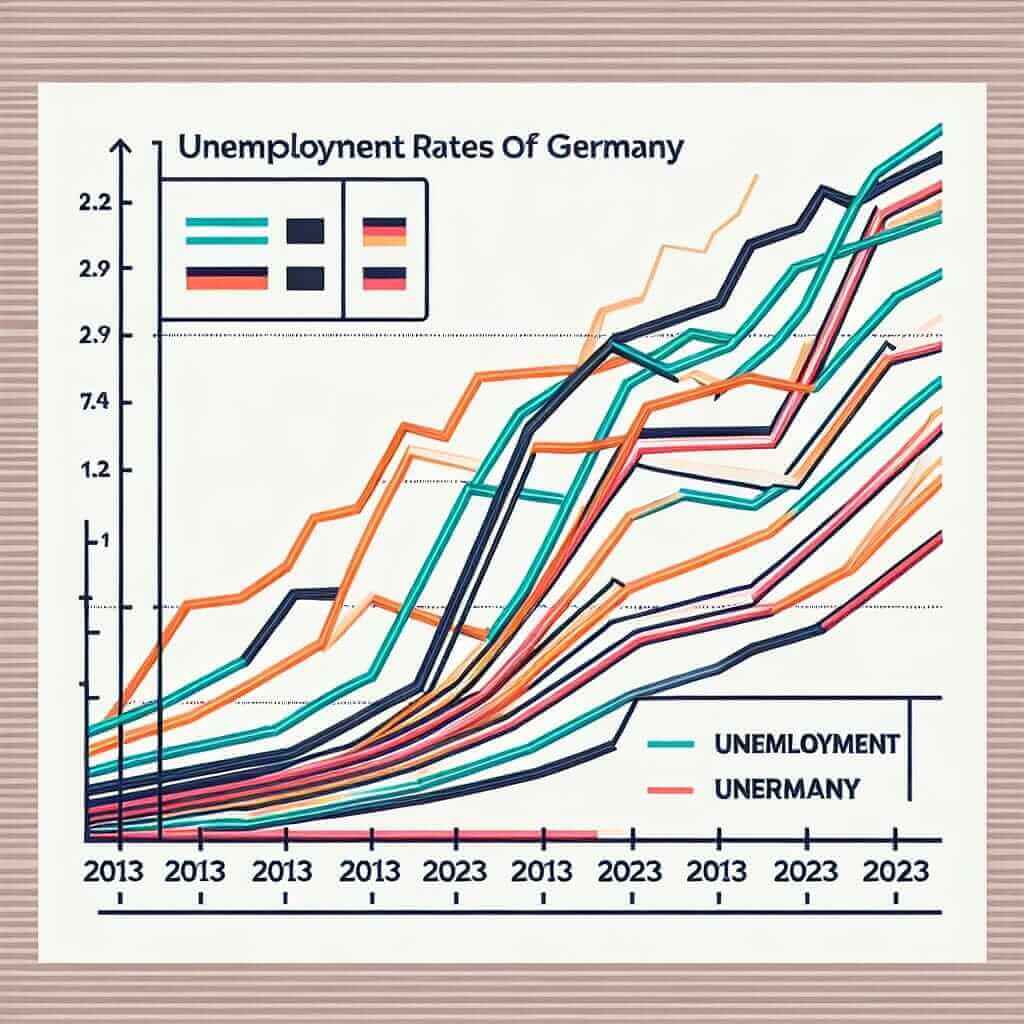In the realm of IELTS Writing Task 1, accurately describing data presented in charts, graphs, or tables is paramount. One common theme that frequently surfaces is comparing economic indicators across different countries. This article delves into the intriguing topic of “Compare the annual unemployment rates in the UK and Germany from 2013 to 2023,” a topic relevant to both the IELTS exam and real-world economic analysis.
This guide will equip you with the necessary skills to tackle similar IELTS Writing Task 1 questions effectively. We will analyze a sample question, provide authentic data, craft a model answer, and offer valuable insights into relevant vocabulary and grammar.
Sample IELTS Writing Task 1 Question
You should spend about 20 minutes on this task.
The chart below shows the percentage of unemployed people in the UK and Germany between 2013 and 2023.
Summarize the information by selecting and reporting the main features and make comparisons where relevant.
(Insert a relevant chart or table illustrating unemployment rates in the UK and Germany from 2013 to 2023).

Data Analysis
To illustrate this task, let’s assume the following data represents the unemployment rates in the UK and Germany from 2013 to 2023:
| Year | UK Unemployment Rate (%) | Germany Unemployment Rate (%) |
|---|---|---|
| 2013 | 7.5 | 5.3 |
| 2014 | 6.2 | 5.0 |
| 2015 | 5.4 | 4.7 |
| 2016 | 4.9 | 4.2 |
| 2017 | 4.5 | 3.8 |
| 2018 | 4.1 | 3.4 |
| 2019 | 3.8 | 3.2 |
| 2020 | 4.5 | 3.8 |
| 2021 | 4.9 | 3.7 |
| 2022 | 4.0 | 3.0 |
| 2023 | 3.7 | 2.8 |
Model Answer
The provided line graph illustrates the fluctuations in unemployment rates for both the UK and Germany over an 11-year period, spanning from 2013 to 2023.
Overall, both countries experienced a downward trend in unemployment during this timeframe. However, Germany consistently maintained lower unemployment figures compared to the UK.
At the outset of the period under review, the UK grappled with a 7.5% unemployment rate, while Germany recorded a significantly lower 5.3%. Over the ensuing years, both nations witnessed a decline in unemployment, with the UK’s rate dropping to 4.9% by 2016 and Germany’s reaching 4.2%.
Interestingly, a notable exception to this trend occurred in 2020, coinciding with the global economic downturn triggered by the COVID-19 pandemic. During this year, unemployment figures in both countries rose, with the UK reaching 4.5% and Germany 3.8%.
Despite this temporary setback, the following years showcased a resumption of the downward trend, culminating in 2023 with the UK at 3.7% and Germany at 2.8%.
Word count: 160
Key Points and Vocabulary
Grammar
- Tenses: Use the past tense when describing data points from past years and the present tense for general trends that continue into the present.
- Comparatives and Superlatives: Utilize comparative adjectives (e.g., lower, higher) and superlative adjectives (e.g., lowest, highest) to effectively compare data points.
- Prepositions: Pay close attention to prepositions of time (e.g., in, from, to, between, during) and prepositions of place (e.g., in, at) to ensure accuracy.
Vocabulary
- Fluctuation (noun): an irregular rising and falling in number or amount; a variation.
- Trend (noun): a general direction in which something is developing or changing.
- Decline (noun/verb): a gradual and continuous loss of strength, numbers, quality, or value.
- Significant (adjective): sufficiently great or important to be worthy of attention; noteworthy.
- Consistently (adverb): in every case or on every occasion; invariably.
- Grapple with (verb): engage in a close fight or struggle without weapons; wrestle.
- Coincide (verb): occur at or during the same time.
- Downturn (noun): a decline in economic, business, or other activity.
- Resumption (noun): the action of beginning something again after a pause or interruption.
- Culminate (verb): reach a climax or point of highest development.
Conclusion
Mastering the art of comparing data is essential for excelling in IELTS Writing Task 1. By analyzing data thoroughly, understanding key vocabulary, and employing appropriate grammar, you can confidently tackle questions like the one explored in this guide. Remember to practice consistently, familiarize yourself with diverse chart and graph types, and strive for clarity and conciseness in your writing.